Contents
Description
Chestnuts are trees that grow in many countries of the world. They clean the air well and serve as a real decoration of the streets. The trees have original leaf shapes and fruits in a prickly sheath. During the flowering period, the air is filled with a pleasant aroma.
Children often make autumn crafts from the fruits of the plant. Also, in a number of countries, various dishes are prepared on the basis of chestnuts. However, these are not all interesting facts about chestnuts. In this article, we will share the most interesting details about the plant.
The fruits of the plant Noble Chestnut or Real Chestnut (Castanea sativa Mille). It belongs to the beech family and is grown in subtropical climates in Europe, Asia, North America and the Caucasus.
Nuts ripen in round “boxes” containing 2-4 pieces.
It is worth distinguishing the fruits of the noble chestnut from the fruits of the horse chestnut, which are not edible, and in some cases can lead to poisoning. Horse chestnut is more widespread in Russia, it is used for landscaping cities and is known for its characteristic “candle” bloom. There is only one fruit in the shell of a horse chestnut, it tastes bitter, and not sweet, like the noble chestnut nut.
There is a Chestnut Festival in France. This nut is considered a national product of the French.
It is estimated that 40% of the chestnuts consumed are in China.
Composition and calorie content of chestnut
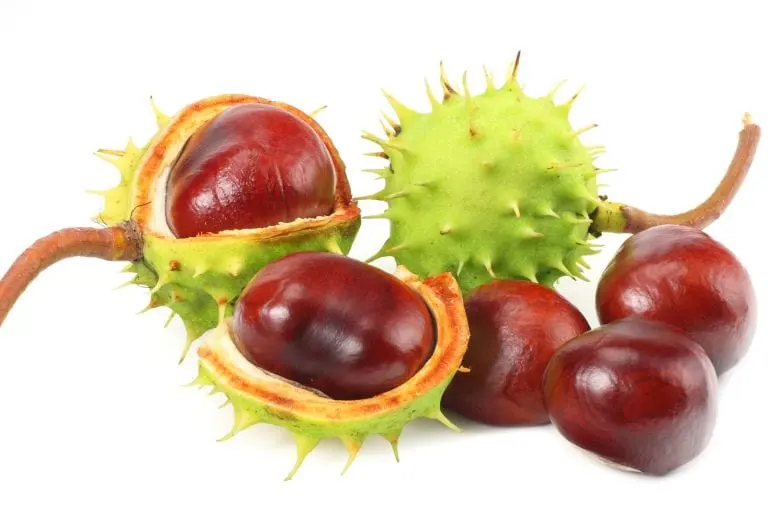
Chestnut contains flavonoids, oils, pectins, tannins, starch, sugars, vegetable protein. This is the only nut that contains vitamin C, it also contains vitamins A and B, mineral elements (iron, potassium).
- Proteins, g: 3.4.
- Fats, g: 3.0.
- Carbohydrates, g: 30.6
- Calorie content – 245 kilocalories
History of chestnuts
Chestnut is a tree of the Beech family with the fruits of the same name. The thin woody-leathery shell of the fruit hides the nut, the edible part of the chestnut. Chestnuts were grown in Ancient Greece and Ancient Rome.
The Romans used them for food, and the Greeks used them as medicine. The Romans brought chestnuts to Britain. From Europe, chestnuts have spread throughout the world.
Chestnut trees have been growing on our planet since prehistoric times. The first mention of the plant dates back to 378 BC.
The fruits of the plant were once called “rice that grows on a tree.” This is due to nutritional characteristics. They are similar to brown rice. However, in reality, the plants have nothing in common and are not related. Chestnuts can grow for over 500 years. And most of this time they bear fruit.
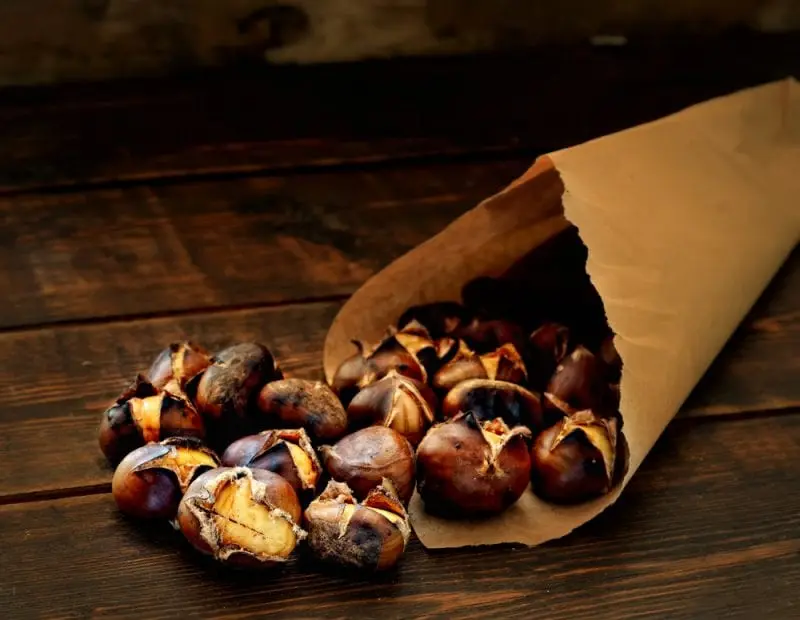
True, people destroy trees much earlier. In medicine, “horse chestnut” is widespread. The plant was brought to Europe from Turkey. It was originally used as horse feed. Subsequently, on the basis of the fruits, they began to prepare a cough remedy for animals. That is why the plant got its name.
At the moment, there are about 30 varieties of chestnuts. However, not all of them are suitable for food, and are also used in medicine. A number of varieties are of no use.
Types of chestnuts
Let’s start with the fact that the edible chestnut is completely different from the plant, the fruits of which Kievans can pick up on Khreshchatyk. A special charm to Ukrainian cities is given by the decorative horse chestnut, which got its name for the fact that its fruits have the same color and shine as those of bay horses. Other names for this plant are stomach or esculus.
The flowers, fruits and bark of the horse chestnut are valuable raw materials from which drugs are obtained for the treatment of vascular diseases. In folk medicine, the juice squeezed from fresh flowers is used internally for vasodilation on the legs and for hemorrhoids. From the decoction of the bark of the branches, baths are made for hemorrhoids. An alcoholic tincture of dried flowers is used externally for rheumatic and arthric pains …

But the edible sowing chestnut belongs to a completely different family. It grows mainly in the Mediterranean, the Black Sea region of Asia Minor and the Caucasus. In Ukraine, wild chestnut is found in the Crimea. True, the “civilized” European varieties that are grown in Italy, France or Spain are much larger – the size of a mandarin.
How does an edible chestnut look like?
It can be distinguished by its long, toothed leaves, which are attached to the handle not by an asterisk, but one by one. The trees reach 40 meters in height, and the flowers are ordinary-looking spikelets of yellowish color. The capsule of the fruit is covered with a large number of thin long thorns, and inside (unlike the single horse chestnut) there are 2-4 nuts in the shape of a bulb at once.
The edible nuts themselves are outwardly slightly similar to the fruits of horse chestnut. It is a large, flattened (sometimes almost flat) nut with a thin dark brown shell. The kernel of such a chestnut is white with a sweetish pulp – when fried, its taste resembles dry, crumbly potatoes.
Interesting fact: For chestnut trees, 500 years old is not a record. This plant has existed since prehistoric times. In the 4th century BC. the Romans actively cultivated chestnuts by grinding nuts into flour for baking bread.
Use of chestnuts
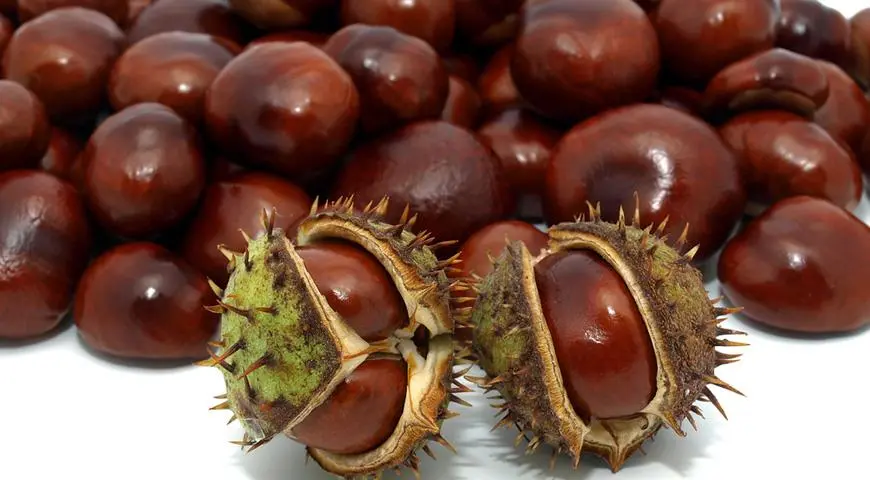
Due to the high content of tannins, it is not recommended to consume raw chestnuts.
They are a common dish in the cuisines of France, Japan, Italy, China, and Asian countries. They can be fried, boiled, baked, stewed.
The most popular dish is roasted chestnuts. To prepare it, the fruits need to be cut cross to cross, which will further facilitate the cleaning of the nut from the shell. Then put the nuts in a frying pan, while it is not recommended to use Teflon, cover with wet napkins so that the chestnuts do not dry out, and close the lid. After 20-30 minutes, the chestnuts will be ready.
During frying, care should be taken to keep the napkins damp and to turn the chestnuts periodically. After frying, it is recommended to quickly peel the peel off the chestnuts, as they will become hard again after cooling.
Chestnuts are recommended to be cooked once as they quickly lose their flavor.
They can also be used to make flour and add it to bread, candy, ice cream, cakes, pastries. Chestnut flour is used in Corsica for baking bread, in the nuts themselves – for making chestnut soup with garlic and onions, as a side dish for stews.
France is known for its tradition of roasting chestnuts in the streets. There is a national French holiday called “Taste Week”, which is based on the “Festival of chestnuts”.
Chestnuts go well with mulled wine, Norman cider, shrimp, orange mousse, asparagus, scallops.
In Japan, they are prepared with chicken and rice, or served as a beer snack. In China, chestnuts are popular as an additive to meat. Also, dishes made from the meat of pigs that were fed with chestnuts are especially appreciated there.
Beneficial features
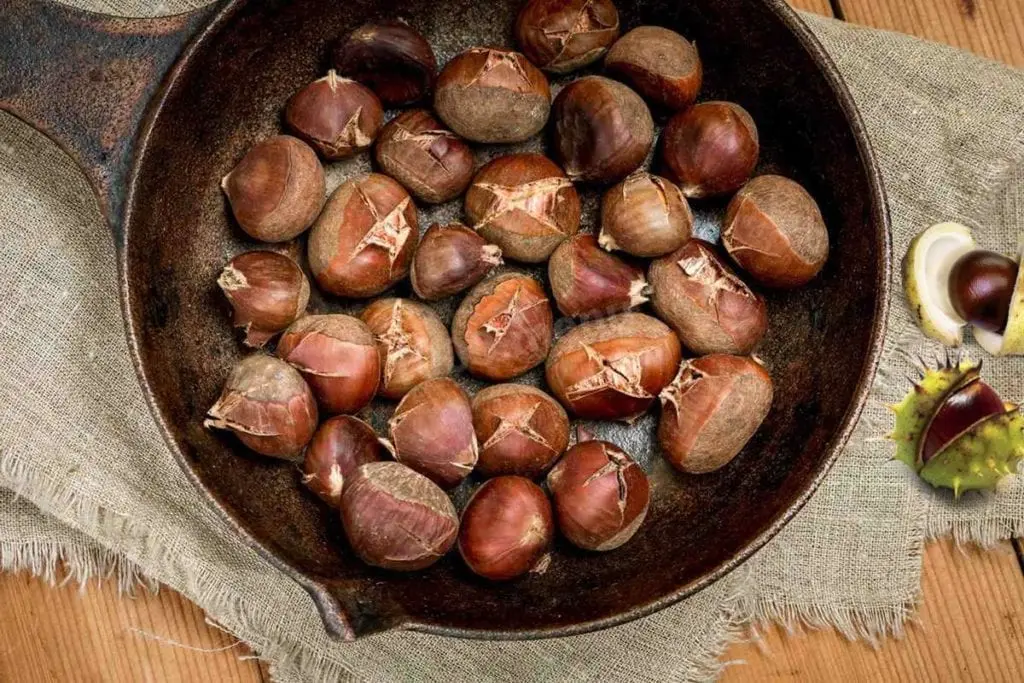
Chestnuts contain a large amount of substances beneficial to the body, which help to increase immunity, general strengthening of the body.
For medical purposes, decoctions, infusions or alcoholic tinctures of chestnut are used. They are used for atherosclerosis, hypertension, diseases of the cardiovascular system, liver diseases, articular rheumatism, varicose veins, gynecological diseases, hemorrhoids, thrombophlebitis, blood stagnation in the small pelvis.
Contraindications
Horse chestnut products are contraindicated in children, women with menstrual irregularities, pregnancy and lactation, people suffering from low blood pressure, atonic constipation, hypoacid gastritis, poor blood clotting.
Patients with renal insufficiency taking chestnut medications need constant medical supervision. All persons wishing to be treated with this plant need to take a blood test for prothrombin, and if the reading of this protein decreases, then you must immediately stop taking the drug.
It must be remembered that the recommended dosage of the used medicinal infusion or other medicine must not be exceeded. Pets are shown to gnaw the fruits of the chestnut, the consequence is severe poisoning. It is necessary to supervise the children, since the fruits of this tree are inedible.
Interesting Facts
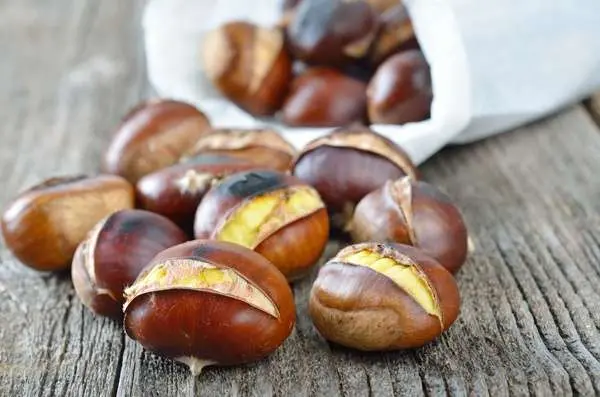
The oldest chestnut tree is a tree that grows in Sicily. It is also the fattest in the world. The barrel circumference is 58 centimeters. Scientists cannot determine the age of the tree. Presumably it is 2000-4000 years old. The oldest and thickest plant is listed in the Guinness Book.
The chestnut festival is held annually in Italy. During the holiday, guests are treated to dishes made from the fruits of the plant. Several years ago one of them was included in the Guinness Book.
The chef of one of the renowned Italian restaurants made chestnut flour noodles 100 meters long. The specialist worked all day on the record. He personally kneaded the dough and formed the noodles using a special pasta machine.
Subsequently, the noodles were sliced and boiled until al dente. All visitors of the festival were treated to the dish. The guests and judges liked the chestnut noodles so much that they instantly ate everything without a trace.
In Geneva, for 2 centuries, there has been a tradition to declare the onset of spring by a special decree when the first leaf blooms on the “official chestnut” growing under the windows of the cantonal government building.
According to statistics, most often spring was announced in March, although often earlier, and in 2002 the chestnut blossomed on December 29. The most paradoxical year was 2006: first, spring was announced in March, and then again in October, as the tree suddenly bloomed again.
In 1969, the chestnut became the emblem of Kiev – due to the fact that it was pleasant to look at, and its leaves and flower had a well-ordered shape.









